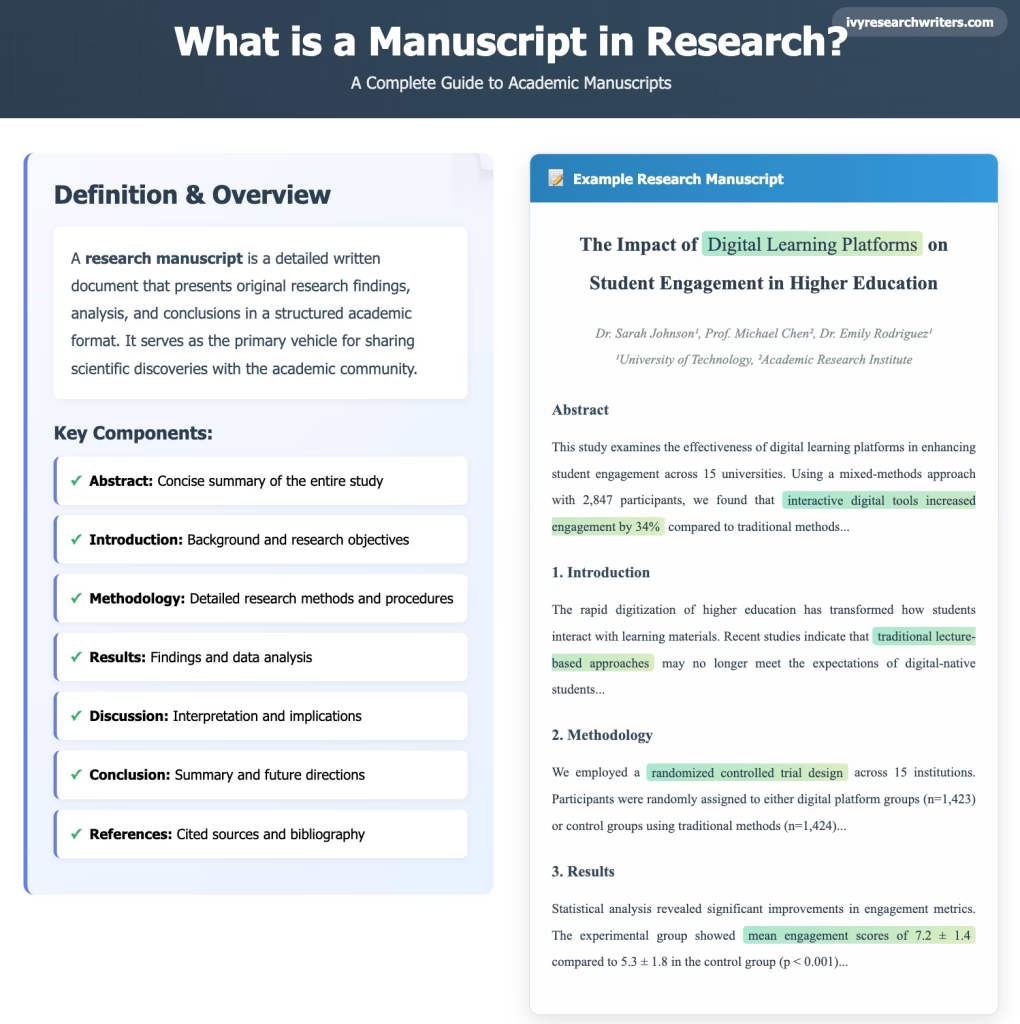What is a Manuscript in Research? Understanding Its Importance in Academic Writing

In the world of academic research, a manuscript is a crucial document that serves as the foundation for sharing original research findings with the scholarly community. A manuscript in research is essentially the preliminary version of an article that is submitted for publication in a journal or other academic platforms. It serves as the means through which researchers communicate their findings, hypotheses, and contributions to their field. In this post, we will explore the definition of a manuscript, its importance in the research process, and its role in academic communication.
What is a Manuscript in Research? Defining the Term
A manuscript in the context of research is the document that outlines the details of a study, including its methodology, findings, discussion, and conclusion. It is the first draft of an article that the author prepares for submission to an academic journal. The manuscript writing process involves organizing research into a clear structure, where the introduction outlines the research question, and the discussion delves into the interpretation of the results. The abstract provides a summary of the study, while the reference list includes citations of prior research that support the study’s context.
Example of a manuscript: Imagine you’re a researcher studying the effects of sleep on cognitive performance. Your manuscript will describe the method you used to collect data, such as the sleep duration and cognitive tests, and present your findings in the discussion. The manuscript will end with a conclusion summarizing the key takeaways and implications of the study.
The Structure of a Manuscript in Research
The structure of a manuscript is essential to ensure clarity and coherence in presenting the research. Although the structure may slightly vary depending on the discipline, most manuscripts follow a typical format that includes the following sections:
- Abstract: A brief summary of the entire study, outlining the purpose, methods, findings, and conclusions.
- Introduction: The background information that explains the context of the research, the research question, and the objectives.
- Literature Review: A summary of previous studies related to the topic, showcasing what is already known and where your study fills gaps in knowledge.
- Methodology: An explanation of the methods used to conduct the research, including data collection and analysis techniques.
- Findings: The results of the study, presented with data and statistical analysis.
- Discussion: An in-depth exploration of the findings, how they relate to existing literature, and their broader implications.
- Conclusion: A concise summary of the study’s findings and their significance, often with suggestions for future research.
- References: A reference list that cites all the sources referenced throughout the manuscript.
The Manuscript Writing Process: From Draft to Publication
The journey of creating a manuscript begins with a first draft, where the author organizes their ideas and research findings into the aforementioned structure. This initial draft is typically reviewed by the researcher or co-authors before it is submitted for formal peer review. The peer-reviewed process is essential for ensuring that the manuscript meets the standards of the academic community. It helps to verify the methodology, findings, and conclusions are accurate and that the study contributes valuable knowledge to the field.
Once a manuscript is accepted for publication, the publisher will format the article according to the journal’s requirements, which might include revising the format and adjusting the page layout for print or online publication.
Example of a Journal Manuscript: How the Process Works
A journal manuscript is a specific type of manuscript that is submitted to a peer-reviewed journal for potential publication. For instance, an academic researcher studying social behavior might conduct an experiment to measure how social media affects self-esteem. The researcher then writes the manuscript, which includes the methodology, data collection, and an in-depth discussion of the findings. After the manuscript is completed, it is submitted to a journal. The editor and peer reviewers assess the manuscript for accuracy, relevance, and contribution to the field. If accepted, the manuscript will undergo final revisions before being published in the journal.
Writing a High-Quality Manuscript: Tips and Best Practices

Writing a manuscript that meets the standards of academic writing can be challenging but highly rewarding. To ensure the manuscript writing process leads to a high-quality article, keep the following tips in mind:
- Clarity and Conciseness: Be concise in your writing while ensuring your message is clear. Avoid overly complex sentences and jargon.
- Logical Structure: Ensure your manuscript follows a clear structure with a well-defined research question, methodology, discussion, and conclusion.
- Thorough Review: Before submitting, summarize your key findings and ensure the manuscript has consistency in its arguments. Address any controversy or issues that may arise in the discussion.
- Citation: Properly cite all the references used throughout your study to avoid plagiarism and give credit to previous works.
- Peer Review: Once submitted, be open to peer review feedback and incorporate any suggestions for improvement.
The Role of the Author in Manuscript Writing
As the author of a manuscript, you play a key role in ensuring that the research is presented in a clear, coherent, and logical manner. The author’s responsibility extends beyond writing; it includes making sure that the manuscript accurately reflects the research process, provides novel insights, and is relevant to the field. Additionally, as the author, you must ensure that all information sources are properly referenced and that ethical guidelines, such as avoiding plagiarism, are followed.
Ready to craft your research manuscript?
Let our experts guide you through the process of writing, editing, and preparing your manuscript for publication. Start your journey towards academic success today!
Conclusion: The Significance of Manuscripts in Academic Research
In academic research, a manuscript is more than just a document; it is the primary vehicle for sharing your findings with the broader scientific community. A well-written manuscript plays a crucial role in advancing knowledge and fostering intellectual exchange across disciplines. By adhering to a logical structure, maintaining objectivity, and following publication guidelines, researchers can successfully publish their work and make meaningful contributions to their fields.
Whether you are submitting to a peer-reviewed journal or preparing your manuscript for a research conference, this essential document is the first step toward having your research findings recognized, discussed, and built upon by the global academic community.
FAQs: What is A Manuscript in research Paper: A Scientific Guide
What is an Example of a Manuscript?
An example of a manuscript could be the initial script of a research paper that a researcher submits to an academic journal for publication. This manuscript typically includes an abstract, introduction, methodology, findings, discussion, and conclusion. It provides the fundamental information of the study, and it is structured to be reviewed by peers before it can be accepted for publication. A manuscript might also include references to previous research, citing sources and drawing connections between existing literature and the study at hand. For example, a research paper on the impact of climate change on agriculture could be considered a manuscript when it is in its preliminary form, before it’s accepted for publication in a journal.
What is the Difference Between a Manuscript and a Journal Paper?
The primary difference between a manuscript and a journal paper lies in their stage in the publication process. A manuscript is an early version of an article, typically submitted to a publisher or journal for review. It contains the full content of the research but has not yet gone through the peer review process or received approval for publication. After the manuscript is reviewed, revised if necessary, and accepted, it is published as a journal paper. Therefore, the manuscript is the draft version, while the journal paper is the final, published version that has passed through review, edits, and formatting by the publisher.
What is the Difference Between a Thesis and a Manuscript?
A thesis and a manuscript both involve original research, but they serve different purposes and are used in different contexts. A thesis is typically a comprehensive document that presents a research project done as part of completing an academic degree, such as a Master’s or Ph.D. It is often longer and more detailed, including not only research findings but also an extensive literature review, a thorough discussion, and sometimes an exploration of broader theoretical frameworks.
A manuscript, on the other hand, is a document prepared for publication in an academic journal. It is more concise than a thesis, focusing primarily on the research findings and their significance, and is structured according to the specific guidelines of the journal. While a thesis is a requirement for academic degrees, a manuscript is typically written to contribute to the research community and get published.
What is the Definition of a Manuscript?
A manuscript is defined as a script or document that contains the original work of a researcher or author that is intended for publication. It serves as the first draft or preliminary version of an academic or literary piece before it is reviewed, revised, and formally published. In academic research, a manuscript includes an introduction, methodology, findings, and discussion, with references to support the study’s claims. It’s essentially a research paper or article that is submitted to an academic journal for review, where it is analyzed and edited before final acceptance and publication. A manuscript is fundamental in the research process as it translates raw data into a structured, formal academic piece for dissemination.

